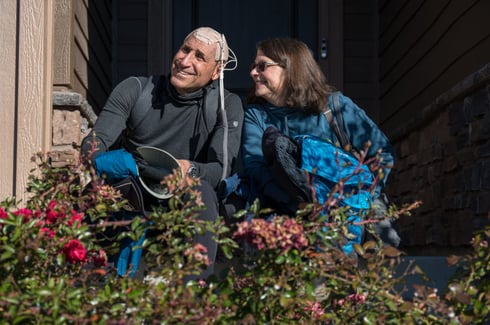Thanks in part to clinical trials overseen by researchers at the University of Colorado Cancer Center, a wearable, portable electrical device called Optune is proving successful at treating a type of brain tumor called a glioblastoma.
“Being in the field that we’re in, we're always looking for exciting and promising technologies,” says CU Cancer Center member Douglas Ney, MD, who helped to oversee the clinical trial of the technology at CU in the early 2010s. “We were very excited about it at the time. There's always a healthy dose of skepticism with anything that you put to a trial, but fortunately, Optune turned out to show a clear survival benefit.”
Glioblastomas, explained
Glioblastomas are a type of glioma, a brain and spine tumor that starts in glial cells, the supporting cells of the brain. About 30% of all central nervous system tumors are gliomas, and about 50% of central nervous system tumors in children are gliomas. Specifically, glioblastomas are a type of astrocytoma, a tumor that can form in the brain or spinal cord. Astrocytomas in the brain can cause seizures, headaches, and nausea, and astrocytomas in the spinal cord can cause weakness and disability in the affected area. About 20% of all brain tumors are astrocytomas, and they are more common in children than adults.
“The interesting thing about the landscape for glioblastoma is that we really have had very few positive clinical trials,” Ney says. “When the results of this trial were published in 2017, it really was the first positive clinical trial since 2005. It took us 10 years to make a dent in the treatment of this, so there was a lot of enthusiasm about it.”
How Optune helps
The Optune device works by producing alternating electrical fields that penetrate into the brain and affect cancer cells, causing them to die before they can replicate.
“It basically polarizes the cell,” Ney says. “One side of the cell becomes positive, and one becomes negative. In order for a cancer cell to grow, all the little pieces of machinery within that cell need to line up in the center of the cell so they can replicate. But when you polarize the cell, each of those little pieces inside the cell now have their own inherent electrical charge. So they're pulled to the side of the cell, and they're not able to line up in the center of that cell, and then the cell undergoes what we call apoptosis, which is a fancy name for cell death.”
Used in conjunction with chemotherapy, Optune is approved for patients who already have had surgery to remove most of their tumor. It is typically worn for an average of 18 hours a day over a 30-day period, but the more patients wear it, the better it works, Ney says.
“I have some patients who are averaging 90% to 95% compliance, which means that over a 30-day period they have it off maybe a couple of hours at most,” he says.
Optune can be worn during sleep and physical activity; the only time it can’t be worn is when a patient is bathing or in water. The device doesn’t cause pain, but it can be cumbersome and uncomfortable, Ney says. Some people can’t tolerate it, but for those who can, it can be life-changing.
“What we have found is that there are some patients who are just really motivated, and they're going to make it work no matter what,” Ney says. “Those are the patients who do really well. They understand that it's a lifestyle change, a commitment, but they're very motivated to make the technology work. That lifestyle change may not be amenable to everyone, but those who are really motivated seem to do really well with it.”
Success story
One of Ney’s motivated patients is Ira Bornstein, 68, who started wearing the Optune device in November 2020, after undergoing surgery for his glioblastoma. Optune has helped to keep his cancer from coming back since then, Bornstein says. The device has caused sores and infections — and lots of questions from TSA agents at the airport — but the benefits are worth it, he says.
 Ira Bornstein and his wife, Sandy.
Ira Bornstein and his wife, Sandy.
“You have to make your commitment to it,” Bornstein says. “It's not painful; it's not invasive. It can be a pain in the butt at times, but you adapt to it. I do just about everything wearing this device. I hike at altitude, I snowshoe at altitude, I walk every day, all while wearing the device. I've even done aerial yoga wearing this device.”
“We've traveled three times internationally this year alone,” adds Ira’s wife, Sandy. “Ira still skis, still works in the yard. His quality of life, fortunately, has not yet been affected by this terrible disease. We're going to maximize as much as we can, because we know that at any given moment, things can abruptly change.”
For Ney, the success patients like Bornstein have had with Optune is not only gratifying, but motivation to keep recommending the device to other patients who have undergone surgery for glioblastomas.
“It's another tool we have in our arsenal,” Ney says. “It's not a cure, but it clearly extends survival. For patients who haven't already heard about it, it can seem like this thing out of an Orwellian dystopian future. But when you explain the science behind it, people get interested pretty quickly."
Images ©2022 Novocure GmbH




